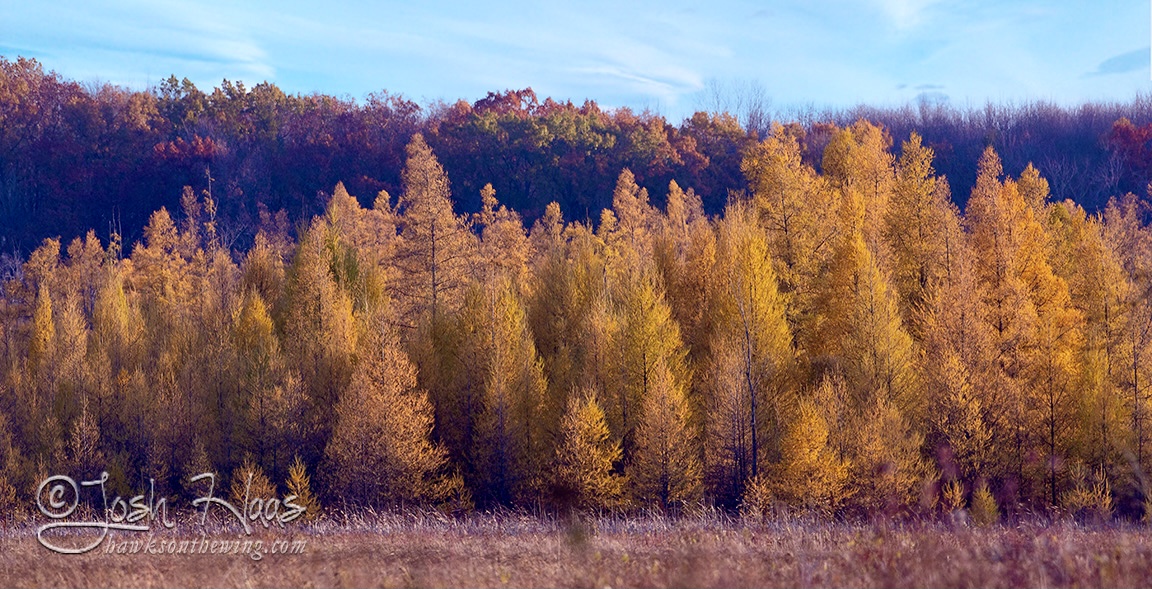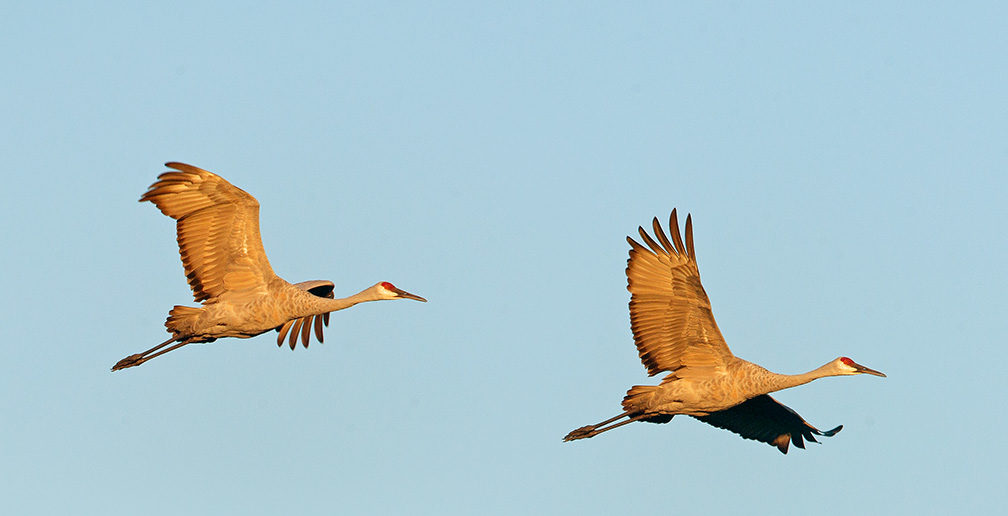Each year, the U.S. Fish and Wildlife Service (USFWS) asks volunteers to help conduct an annual standardized count of the Eastern Population Sandhill Cranes during a specified week-long period. This annual survey began in 1979, with state and federal agencies and volunteers participating in eight states and one province (Ontario, Canada) along the Atlantic and Mississippi flyways. This year, the survey period fell between Oct. 26 and Nov. 4.
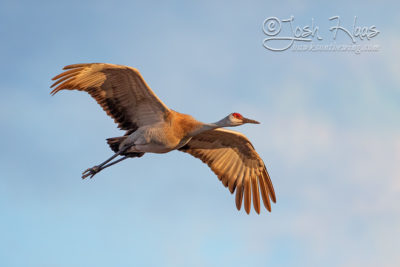
Sandhill Crane. Photo by Josh Haas
Since the official annual survey began in 1979, the Eastern Population Sandhill Crane count has grown to more than 90,000 individual cranes! In the last 100 years, the Sandhill Crane population in Michigan was at its all-time low, having been hunted nearly to extinction and suffering from the loss of wetland habitat throughout the state. Active conservation work to support Sandhill Cranes and restore wetland has resulted in a success story for Sandhill Cranes in Michigan. Continued monitoring of habitat and Sandhill Crane population numbers is critical for sound management decisions now and in the future.
Michigan Audubon contributes data from two of our bird sanctuaries, Bernard W. Baker Sanctuary and Phyllis Haehnle Memorial Sanctuary. At Baker Sanctuary, the cranes roost in Big Marsh Lake. We conduct the count from the best vantage point on neighboring property, the Kiwanis Youth Conservation Area (referred to as Big Marsh Lake in this blog, for simplicity). At Haehnle Sanctuary, the official crane count includes only the tally from Mud Lake Marsh, but volunteers also help cover other nearby locations for the USFWS annual crane survey and submit those data to USFWS.
This year, two Michigan Audubon staff, Linnea Rowse and Lindsay Cain, and one volunteer, Josh Haas, conducted the count at Big Marsh Lake on Nov. 2. At Haehnle Sanctuary and the surrounding area, the count was conducted by volunteers Steve Jerant, Gary Siegrist, Ross Green, and Ron Hoffman, also on Nov. 2.
It can certainly be a challenge to keep an accurate count of hundreds or thousands of cranes in one evening, especially with small flocks flying into the roost site from multiple directions, some lifting off and departing, perhaps circling and re-settling, or avoiding a predator before settling down again. Observers do the best they can, using common methods to track and count individual birds.
When there is more than one observer, communication is key. One person is usually the primary observer and tallies all numbers, while other counters help track incoming flocks and other bird sightings. While one observer might be counting flocks streaming in from the east, another observer may sight and count birds flying in from the west. A lot of verbal communication back and forth between observers is important so that a flock of several cranes is not double-counted and to help keep track of a group of cranes that may be circling the sky above the marsh before landing. It’s a challenge, but also fun! Cranes were counted until we could no longer see well enough to track incoming cranes in the deepening dusk.
Click here for the full eBird list from the Baker count at Big Marsh Lake.
A few other highlight bird species from the count at Big Marsh Lake included:
- A total of 34 bird species were observed during the crane count
- 2 Great-horned Owl calling back and forth
- 4 Trumpeter Swan, local to the area and known to breed at Baker Sanctuary
- 9 Bald Eagle — two breeding pairs are common to the site, with additional migrants likely in the area
- 12 Rusty Blackbird
- 52 Cedar Waxwing
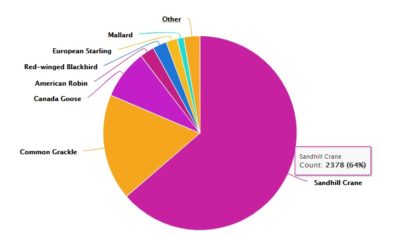
2019 Dunkadoo Species Pie Chart
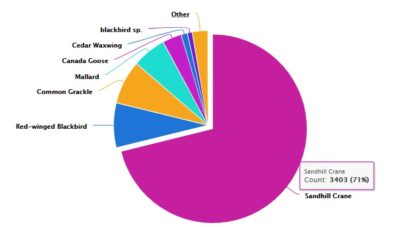
2020 Dunkadoo Species Pie Chart
At Haehnle Sanctuary, Gary Siegrist reported observing 377 Sandhill Cranes roosting in Mud Lake Marsh and an additional 656 cranes flying by north of the sanctuary, for a total of 1,033 cranes. He also reported two new species for the autumn at Haehnle: American Tree Sparrow and Rough-legged Hawk.
At other locations near Haehnle, 786 Sandhill Cranes were counted at Hawkins Road near Portage Lake. Another 698 cranes were counted on private property north of Haehnle, which was about a 4,000% increase from the 2019 count at that location. Steve Jerant reports, “[He] did [his] best Galileo impression by accidentally looking at the sun with binoculars while following a large group of cranes. But we did have a beautiful sunset.” Oh, the hazards of birding! I know Steve is not the only birder to have done this…
Past crane count data for Haehnle are available here and on the Jackson Audubon Society website.
Click here for the full eBird list from the Haehnle count at Mud Lake Marsh.
Highlights from the count at Haehnle included:
- A total of 23 bird species were observed at Haehnle during the crane count
- 3 Trumpeter Swan, from the family group that nested successfully at Mud Lake Marsh in 2020
- A handful of raptor species: 2 Northern Harrier, 1 Cooper’s Hawk, 1 Bald Eagle, 1 Red-tailed Hawk, and 1 Rough-legged Hawk
- 2 Purple Finch
- 1 American Tree Sparrow
Past crane count data at Baker Sanctuary is archived on the USFWS crane count data page, with total count numbers summarized in a chart below from 2010 to 2020.
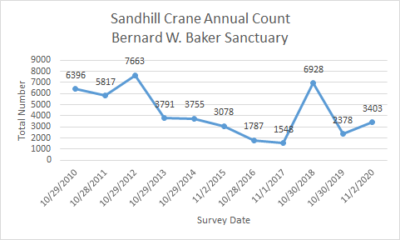
You can learn more about Sandhill Cranes and where to view them during migration in our recent blog post.
~ by Conservation Program Coordinator Linnea Rowse
Play the video below to enjoy the sound of Sandhill Crane coming in to roost at Big Marsh Lake.
